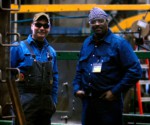 Whenever you work with people, the impression you make on these people is important. Your clothes and behavior have a great influence on this impression. This post discusses strategies for your appearance to increase your chances of success on lean manufacturing projects.
Whenever you work with people, the impression you make on these people is important. Your clothes and behavior have a great influence on this impression. This post discusses strategies for your appearance to increase your chances of success on lean manufacturing projects.
In the Boardroom
![]() Chances are, with lean manufacturing projects you are at the intersection between the shop floor and management. I find myself occasionally reporting to upper-level management or even the CEO on the status of the project. Naturally, I want to convey an impression of professionalism and competence. In the Western world, this means for men a full dark suit, collared shirt, black belt and shoes, and a necktie. In some companies, there is even an informal color standard for the suits. If you want to fit in, you need to adapt your outfit.
Chances are, with lean manufacturing projects you are at the intersection between the shop floor and management. I find myself occasionally reporting to upper-level management or even the CEO on the status of the project. Naturally, I want to convey an impression of professionalism and competence. In the Western world, this means for men a full dark suit, collared shirt, black belt and shoes, and a necktie. In some companies, there is even an informal color standard for the suits. If you want to fit in, you need to adapt your outfit.
Furthermore, you also can adjust your behavior and phrasing. Fancy words do impress more in this environment. With respect to lean, Japanese words may help here. Rather than continuous improvement, it is kaizen. Instead of leveling, use heijunka. Mistake proofing becomes poka yoke, and so on. On a side note, professional titles (Ph.D., professorship, academic degrees, etc.) can help you with your impression.
On the Shop Floor
 Of course, on the shop floor, dress code is very different. On the shop floor, I also want to convey an impression of professionalism and competence. However, if you go to the shop floor in a full dark suit and tie, shove your academic degrees into everybody’s face, and use a plethora of foreign-language buzzwords, you may as well go back to the boardroom. With this approach, you will not reach the people on the shop floor. They will consider you an outsider, and they won’t understand you, won’t trust you, and will be reluctant to work with you. Since the success of lean manufacturing projects is decided on the shop floor, this effectively means that your project will most likely fail.
Of course, on the shop floor, dress code is very different. On the shop floor, I also want to convey an impression of professionalism and competence. However, if you go to the shop floor in a full dark suit and tie, shove your academic degrees into everybody’s face, and use a plethora of foreign-language buzzwords, you may as well go back to the boardroom. With this approach, you will not reach the people on the shop floor. They will consider you an outsider, and they won’t understand you, won’t trust you, and will be reluctant to work with you. Since the success of lean manufacturing projects is decided on the shop floor, this effectively means that your project will most likely fail.
On the other hand, dressing up in blue-collar work clothes will look weird. After all, you are most likely not a worker at this plant, and trying to adapt over-eagerly will also fail.
A Compromise
 As a compromise, I usually go for black jeans or khaki pants and a dress shirt (known as smart casual or business casual). This way I won’t look too distant to the shop floor, but will also look somewhat respectable to management. If necessary, a tie and a jacket can be added quickly for management meetings. Hence it is acceptable on the shop floor and tolerable in boardrooms.
As a compromise, I usually go for black jeans or khaki pants and a dress shirt (known as smart casual or business casual). This way I won’t look too distant to the shop floor, but will also look somewhat respectable to management. If necessary, a tie and a jacket can be added quickly for management meetings. Hence it is acceptable on the shop floor and tolerable in boardrooms.
Naturally, I do not mention any of my titles and try to explain concepts in English on the shop floor. I also avoid any foreign-language or buzzwords. Most buzzwords have been around on the shop floor already, usually with less-than-stellar success. Hence shop floor workers are wary of such phrases. To have a successful project on the shop floor, you need to earn the workers’ trust. Dressing accordingly is not everything, but it is one aspect of this.
The Easy Way Out

In some cases, the dress problem is solved by the workplace requiring a certain style of clothing. These are usually to either protect the workers or the products. In this case, everybody regardless of hierarchy must dress up in this fashion. Common examples are clean rooms, environments with toxic gases or particles, eye protection in welding areas, reflective vests and helmets in warehouses, etc.
Summary
It is important to dress and behave in relation to the people you are working with. In lean manufacturing, this is frequently both the shop floor and management, hence you need to find a compromise. With this post I probably didn’t reveal anything groundbreakingly new to you, but I wanted to remind you about this often-overlooked fact. For example, McKinsey is known for suits and tie. However, during my consulting days, my colleagues and I rarely wore suits on the shop floor. In some cases, I even went to work in jeans and T-shirt simply because everybody wore the same company T-shirt. I hope this reminder is helpful for you.
No go out and improve your Industry!
